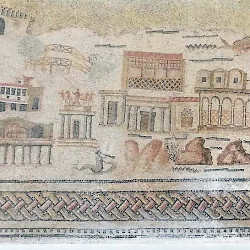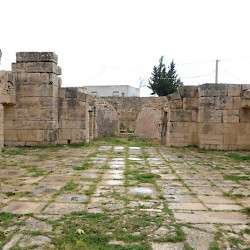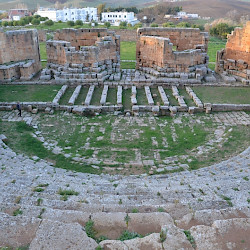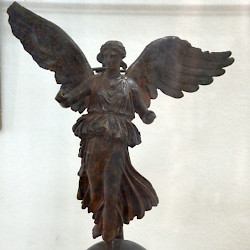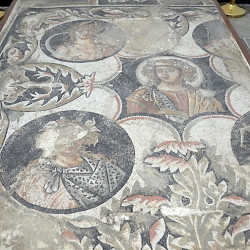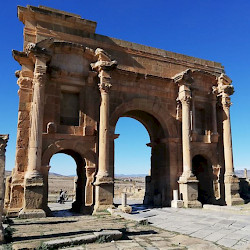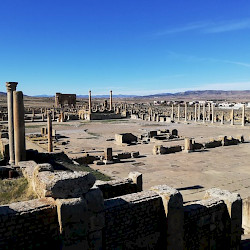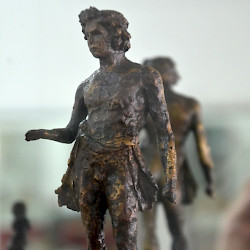Numidia
Q102679Numidia: ancient country to the west of the territories of Carthage, more or less modern Algeria. There were two main units, named after the Massylians and the Masaeisylians, which are more or less identical to the Roman provinces Numidia and Mauritania.
The country
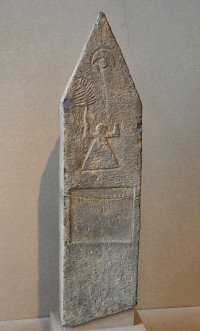
Behind the southern shore of the Mediterranean Sea, behind the ports of Caesarea (modern Cherchell), Tipasa, Icosium (Algiers), and Hippo Regius (Annaba), begin the highlands of Numidia. A traveler arriving from the north would first cross the eastern continuation of the Tell Atlas, would reach the undulating "Hautes Plaines", and would cross the Sahara Atlas before reaching the sandy desert, the Grand Erg. In the east, the two mountain chains joined in the part that is called Aurès. In the mountains, yellow marble (giallo antico) was quarried.
The country is quite fertile and in Antiquity, the people were sedentary, as is correctly observed by the Greek researcher Herodotus.note That the Numidians were predominantly roaming shepherds, is a misunderstanding based on the fact that their name resembles the Greek word νομάδες (nomads), which refers to pastoral tribes. However, even though most people were sedentary, there were nomadic Numidians as well, who built cabins on wheels called mapalia.note
History
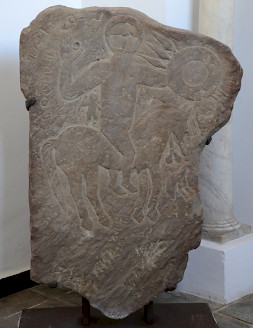
The Numidian shores were first explored by the Phoenicians, who founded several colonies (e.g., Iol and Hippo Regius, modern Cherchell and Annaba). From here, they traded with the Numidian farmers in the interior.
Numidia consisted of two political units. In the east, in the Aurès, closest to Carthage, lived the Massylians. In the west, in the direction of the Atlas Mountains, on the Hautes Plaines, lived the Masaeisylians. Both were famous for their cavalry, which served in the army of Hannibal during the Second Punic War (218-202).note Among the known Numidian leaders were the Carthaginian ally Syphax of the Masaeisylians and the Roman ally Massinissa of the Massylians (r.202-148). Massinissa benefited from his alliance with Rome: after the Second Punic War, he could add the cities of Sabratha, Oea, and Lepcis Magna in modern Libya to his kingdom.
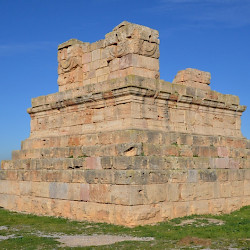 Soumaa d'el Khroub, Mausoleum of a Numidian king (Micipsa?) |
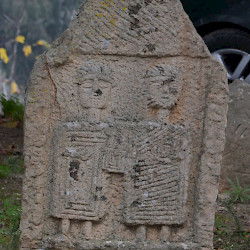 Hippo Regius, Numidian stele |
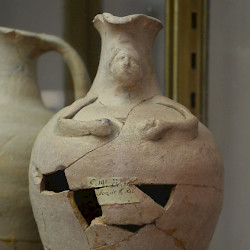 Chullu, Numidian oenochoe |
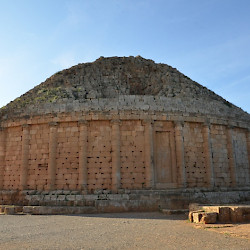 Mausolée royal de Maurétanie: the Mausoleum of Juba II (?) |
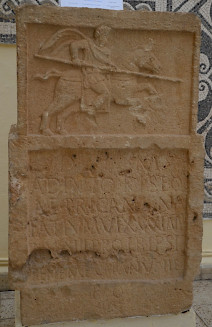
He died in 148 BCE, more or less when the Roman commander Cornelius Scipio captured Carthage and conquered Africa. Massinissa was succeeded by his sons Micipsa, Gulussa, and Mastanabal, and later by Jugurtha (r.118-104). The latter was defeated by the Roman general Marius; parts of his kingdom were added to the Roman Empire. In 46 BCE, Julius Caesar added more Massylian territories (text; “Numidia Nova”). The country, which had until then been dominated by hillforts (e.g., Tiddis), gradually became more urbanized.
The Masaeisylian part, which opposed Rome under its king Juba I, was later added to the Mediterranean Empire, when the Romans were fighting against rebels like Tacfarinas and his Moorish ally Mazippa (17-24 CE). It became part of the province of Mauritania. Ever since, the Third Legion Augusta, which was based in Tebessa (modern Theveste), would defend the Numidian border.
The emperor Hadrian, who visited the military zone, protected Numidia by building several fortifications, including a new legionary base for III Augusta at Lambaesis (Tazoult). Next to it was the carefully planned new city of Thamugadi (Timgad). The military district was converted into a Roman province by Septimius Severus (r.193-211).
During the reign of Maximian (r.285-305) and and his eastern colleague Diocletian (r.284-305), Numidia became part of the diocese Africa, together with several other provinces in the Maghreb (Mauretania Caesariensis, Mauretania Sitifensis, Africa Zeugitana, Africa Byzacena, and Tripolitana). During the reign of Constantine the Great, the provincial capital of Cirta was renamed Constantine. In this age, the production of olive oil seems to have increased enormeously; this is suggested by the great number of late ancient olive oil presses in older buildings.
The area was seized by the Vandals in 430, was reconquered in 534 by the Byzantine general Belisarius, was fortified by the emperor Justinian,note and finally fell to the Arabs.
Religion
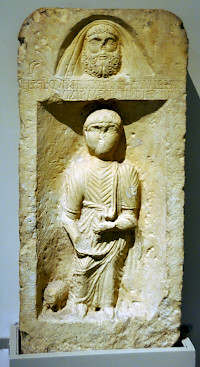
Although we have no access to ancient Numidian literature, we know the names of several deities. For example, in Cirta, a sanctuary has been excavated that was dedicated to Baal-Hammon, the lord of the Netherworld, who would later be identified with the Romans deity Saturn. Votive stelas show the “sign of Tanit”, who would later be called Heavenly Juno. These deities were Punic. Among the original Numidian gods were Aulisua, Iocolon, and Motmanius, known from inscriptions.
The Roman author Cassius Dio refers to religious incantations and enchantments, which were sure to make rain fell from the sky.note Similar incantations are mentioned by Herodotus, who digresses on Numidian customs.note
Christianity is well-documented in the works of Augustine (454-430), who was born in Thagaste, became bishop of Hippo Regius, and is the author of the Confessions and the City of God.
Archaeology
The Numidians buried their dead in bazinas: artificial hills, decorated with small monuments. There are many important cities, like Hippo Regius (Annaba), Thagaste (Souk Ahras), Madauros (M'daourouche), and Tebessa (Theveste) along the Algerian-Tunisian border. The main ports are Isocium (Algiers), Tipasa, and Caesarea (modern Cherchell). In the center are Cuicul (Djemila) and Cirta (Constantine), while the frontier zone is dominated by the legionary base of Lambaesis (Tazoult), the city of Thamugadi (Timgad), and the baths of Mascula (Khenchela).
Literature
Yann Le Bohec, Histoire de l'Afrique romaine (2005)
